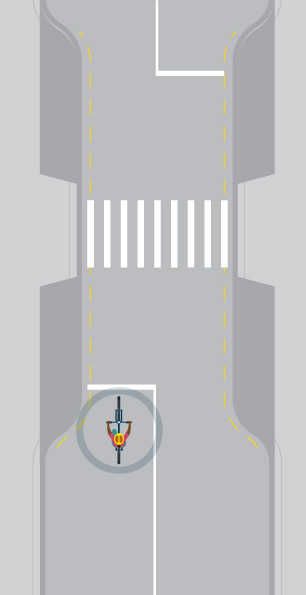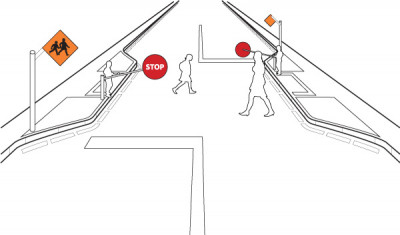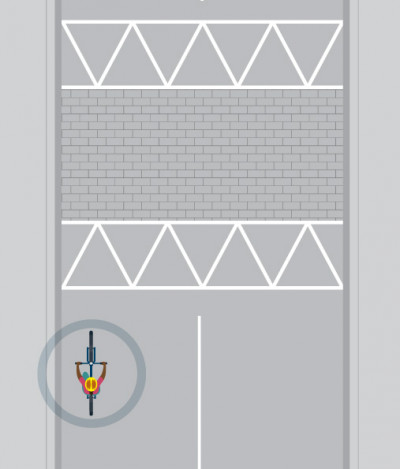Crossings are a type of intersection.
This page describes how to use different crossings and who gives way:
Give way at pedestrian crossings
Marked pedestrian (zebra) crossings
Kea crossings (school crossing points)
Courtesy crossings
Walk your bike across pedestrian crossings
Using shared pedestrian and cycle crossings
Using cycle crossings
Crossing railway lines safely
Pedestrian crossings are intersections where people on foot have priority. If you are riding, you must give way at a pedestrian crossing. Slow down and be ready to stop for any pedestrians on a crossing or waiting to cross. There are a number of different types of pedestrian crossings.
At zebra crossings with no traffic island, stop and give way to people walking on any part of the crossing or who are waiting to cross.
Some zebra crossings have a traffic island in the middle. Stop and give way to people walking on your half of the road or who are waiting to cross.
School patrols sometimes manage a zebra crossing. Stop when a sign is held out and wait until it is withdrawn.

Zebra crossing
A kea crossing is a temporary school patrol crossing without a marked pedestrian (zebra) crossing. Stop when the sign is held out and wait until it is withdrawn.

Kea crossing
Courtesy crossings are usually made of bricks or paving or raised above the level of the road. A courtesy crossing is not an official pedestrian crossing, but to be polite, you should stop for people on the footpath waiting to cross. You must give way to people already crossing.

Courtesy crossing
If you want to cross at a pedestrian crossing you should get off your bike and walk. Cycle crossings, courtesy crossings, and shared pedestrian and cycle crossings are the only crossings you can ride across.
Some crossings are designed for people on foot and people riding bikes. These are often part of shared paths.
Shared crossings may have a set of coloured crossing lights that display bike symbols as well as the normal pedestrian lights. Cross when the bike symbol is green. Pedestrians must only cross when the pedestrian symbol is green – this may be at the same time or separately.
Shared crossings without crossing lights may have markings like a zebra crossing or different markings, for example a dedicated cycle lane beside the striped pedestrian crossing.
If a shared path uses a courtesy crossing, you can ride your bike across without getting off and walking. Vehicles approaching a courtesy crossing don’t need to give way, but they may stop for people waiting to cross.
Ride courteously around people on foot.
Passing other riders and pedestrians
Some crossings are designed for people riding bikes, for example to cross an intersection while using a cycle path. Cycle crossings have a set of coloured crossing lights that display bike symbols. Cross when the bike symbol is green.
When you approach a railway crossing, you should slow down and be ready to stop. If the crossing has active bells, lights or barrier arms, then you must wait until the bells and lights have stopped and the barrier has moved out of the way.
Some railway crossings don’t have bells, lights or barriers. Look as far as you can up and down the railway line to check whether any trains are coming.
Cross the rails with careTo avoid your bike’s wheels getting stuck in railway lines or slipping in wet conditions, cross the rails at a right angle or as close as possible to one. |